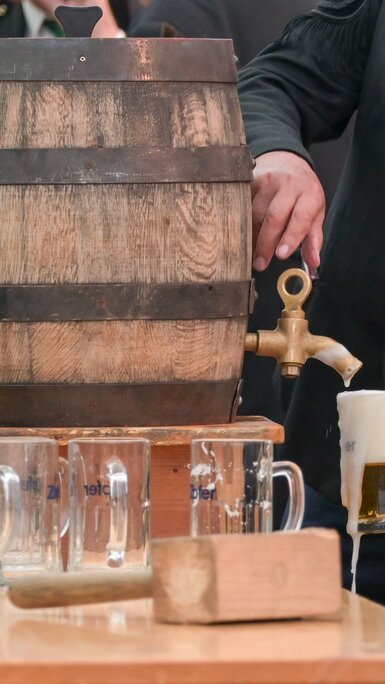A Festival Honoring Millennia-Old Mining Traditions The 18th European Miners’ and Smelters’ Day in Bad Ischl
Colorful uniforms, flags, a lively atmosphere, and the sense of camaraderie and unity shared by thousands of people from across Europe energized a three-day festival in the heart of the Salzkammergut. In short, the corporate slogan of Salinen Austria AG became the motto adopted by all attendees of this special weekend – WE LIVE SALT!
The Festival
After nearly two years of preparation, the time had finally come: around 1500 miners and members of various mining associations from nine different European countries flocked to the imperial city and Cultural Capital of Bad Ischl to spend an entire weekend gaining insights into the past, present, and future of miners. The program included tours, concerts, and lectures – but above all, it was about socializing and bringing together thousands of mining enthusiasts.
Guests from across Europe were offered a lot:
The dedicated festival organizing team put together a diverse program for European and local guests: tours of the Ebensee saltworks and the Altaussee salt mine, as well as fascinating lectures at the Spitalkirche Church in Bad Aussee. The range of topics included a report from scholar Simon Kienesberger on the historical development of salt production in the Salzkammergut from the 18th to the end of the 19th century, historian and Salzkammergut expert Dr. Michael Kurz, who explored the social history of salt workers under the theme “Traditional Resistance,” and Dr. Alfred Stefan, who shared intriguing insights into the saltworks hospital.
Magical experience: The Dürrnberg Sword Dance
On Saturday evening, the Dürrnberg Sword Dance was performed. Since 2011, it has been officially honored as an example of UNESCO Intangible Cultural Heritage. Why does the dance exist? In a nutshell, the various figures involved in the dance – described by an announcer – were used to explain the mining processes to the archbishops of Salzburg whenever they came to visit. Meanwhile, children dressed as dwarves carried torches or sometimes tools (made of wood). During a performance like the one in Ischl on Saturday, a total of 49 people were actively involved. The sword dance is rarely performed nowadays – every four years on average – and only on special occasions. It gives all participants a special sense of pride and honor to preserve this tradition for future generations!
Highlight of the Festival: The Miners’ Parade
The highlight was undoubtedly the Miners’ Parade on Sunday. Colorful uniforms and even a mounted mining officer marched through Bad Ischl to the festival tent located on the grounds of the Bauerpark. Colleagues from Salinen Austria AG, together with the Salzwelten Team, formed the largest contingent with roughly 100 people.
Interesting: The Miners’ Attire – Alike yet Different!*
Especially during the Miners’ Parade, visitors were able to discover the variety and different versions of miners’ attire. No other profession boasts as many traditions as the miners and smelters. Each detail on the uniform represents some kind of reference to actual mining activities. Here are a few explanations certain to intrigue**:
- · The Tunic: Made from black fabric with golden buttons and black and green velvet appliqués – black representing the dark tunnel, green for nature, and gold for the sun above ground.
- · The Hat: Originally a protective head covering worn underground, made of black velvet. On the left side of the cap is a golden embroidered hammer & pick symbol, framed by oak and laurel branches.
- · The Breech Leather: Served both as protection against cold and moisture, allowing miners to sit and work a little more comfortably, and to make the ride down the miners’ slides smoother. Today, it is an integral part of the miners’ attire.
Even for us, being able to admire the various versions of miners’ attire was a great experience! If you want to learn more about the clothing, stay tuned – a dedicated blog post about miners’ clothing is coming soon.
Already Looking Forward to Next Time!
As a memento of their joint contributions to the festival’s success, the participating associations received a beautiful salt stone (what else!) from Altaussee, as well as a heartfelt farewell with the prospect of a reunion just two years from now.
In these dynamic and quite turbulent times of ours, this weekend we realized how important and inspiring the sense of European spirit and solidarity truly are. We are already eagerly looking forward to the 19th European Miners’ and Smelters’ Day from June 12 to 14, 2026, in Přibram in the Czech Republic – GLÜCK AUF!
Until then, feel free to check back in on our blog soon for other exciting topics about Salzwelten, salt mining, and of course, SALT itself!
Glück Auf!
Magdalena & Harald
And the entire Salzwelten Team
To the author
Mag. Harald Pernkopf
Harald is the press spokesperson for Salzwelten GmbH. He makes his home in beautiful Ausseerland and knows the region, as well as the tunnels of our three salt mines, like the back of his hand.
About the author
Magdalena Geistlinger
Magdalena has worked at Salzwelten since 2017. She is responsible for online marketing and social media and has a personal connection to the mine due to her own family history – her great-grandfather worked shifts deep inside the Dürrnberg mine for 40 years. Even as a child, as she played in her garden at the entrance to a magical “mine” of her own imagination, she discovered her first love for the world of salt mining…
Our heartfelt gratitude goes out to the photographers from Plamberger Fotografie, who captured the moment in pictures for eternity – a big thank you for providing us with such beautiful photos!
Wanna see more pictures of the festivities? Click here!
Plamberger Photography* This information is sourced from the BHK – Federation of Austrian Mining, Smelting, and Miners' Associations
** Information from the book “Mining Glossary” by DDipl.-Ing. Mag. Dr. iur. Alois Fellner

